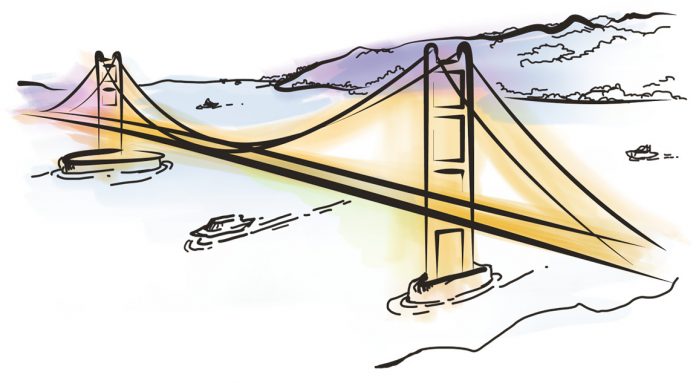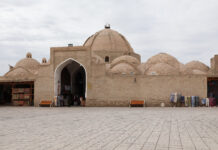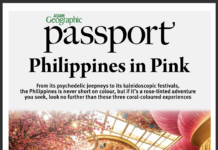
Text by Flash Parker. Illustration by Richard Cag0moc.
The world is full of astonishing bridges. Some are famous, some are infamous and countless others attract no attention at all. Millions of tourists visit the Golden Gate Bridge in San Francisco each year, but how many of them have ever heard of Japan’s Kintai Bridge, a 17th-century marvel that offers stunning views of Mount Yokoyama and an ancient castle from atop its sturdy wooden arches? Folks, the world over, have heard that London Bridge is falling down, but where were they when the Kutai Kartanegara Bridge in Indonesian Borneo crumbled into the Mahakam River?
Travellers embark upon the great train journeys of Europe, the thrilling hikes of Africa and the serendipitous highway adventures of America, yet few ever consider crossing a continent, bridge by bridge. Asia, in particular, is home to countless fascinating bridges that act as a sort of historical connective tissue, linking culture, politics and economics across physical spaces. Without them, there would be no way to get from point A to point B, while the journey from the tropical waters of the Laccadive Sea to the frigid tundra of Siberia wouldn’t be nearly as fun. From Sri Lanka’s southern tip to the Russian port city of Vladivostok, these are some of the bridges that can’t be missed.

Adam’s Bridge, Sri Lanka to India
Adam’s Bridge isn’t just another border crossing. Hindu believe that the bridge was built by Lord Hanuman and his Vanara ape army at the behest of Lord Rama; the Vanara used the bridge to cross from India into Lanka to retrieve Sita, Rama’s consort, from Ravana, the king of Lanka who sought vengeance from Rama for disfiguring his sister, Surpanakha. In the Indian epic Ramayana, Adam’s Bridge is known as Setubandhanam, or Rama’s Bridge. Some of the most famous bridges in the world were built to serve a tactical purpose, but Adam’s Bridge holds the rare distinction of being built by militant monkeys.
Adam’s Bridge spans a distance of roughly 30 kilometres, and seems like an ancient engineering feat on par with the construction of the Pyramids of Giza, but has more in common with Mount Olympus. Geological evidence suggests that Adam’s Bridge is a loose collection of shoals and sand and is more than 3,000 years old, born of a series of natural phenomena.
The bridge links Rameswaram Island in India to Sri Lanka’s Mannar Island, and, in a feature unique to bridges throughout the world, has served to hinder more transportation than it has helped. Adam’s Bridge was passable on foot for a few hundred years, but sometime in the 15th century, a cyclone slammed the shoals and destroyed parts of the bridge. The shallow waters of the Palk Strait have made navigable passage difficult for all but tiny skiffs, captained by pearl fishermen. In contrast to their monkey counterparts, human engineers conquered the strait in the mid-20th century when they built a rail-and-ferry system that transported passengers all the way from Chennai to Colombo. Meanwhile, another cyclone destroyed the bridge in 1964, while politicking, civil war and natural disasters have conspired to wreak havoc on Adam’s Bridge ever since.
While bridges are constantly being built and crumbling, Adam’s Bridge may cease to exist altogether in the near future, as plans are currently being drawn that would see the strait dredged in order to allow large commercial shipping vessels access to India. Better start your journey in a hurry.
The Sino-Nepal Friendship Bridge,
Tibet to Nepal
The Sino-Nepal Friendship Bridge stands tall upon the planet’s apex, overlooking China, Tibet and Nepal. The bridge was built as part of a joint effort to link Kathmandu with Tibet at a time when Sino-Nepalese relations were strong, and tensions between Beijing and Delhi were high. The bridge was finished in 1967, though by that time, trade relations between Nepal and China had cooled (China became involved in the construction of the bridge under the pretence of providing aid), and Kathmandu would reap no rewards for its tremendous efforts in building the highway to Lhasa and the Friendship Bridge. However, the bridge has always held enormous tactical significance for China, as it serves to link two Chinese military installations to one another. How’s that for amity tactics?
As China has eased restrictions on trade, the bridge has been used as a conduit for aid, resources and tourism. Surprisingly, the Sino-Nepal Friendship Bridge is a popular place for bungee jumpers who don’t mind staring the icy waters of the Bhote Kosi River square in the face. The bridge has also become important among Tibetan pilgrims, who use the highway to reach Lhasa, and is noted for its scenic beauty – it is possible to glimpse Mount Everest from the highway, in addition to the peaks of some of the other highest mountains in the world.
The bridge cuts a striking figure as its blue steel connects one mountain to the next, the river raging below. Few bridges on earth can rival the Sino-Nepal Friendship Bridge for scenic beauty, while fewer have been built under such falsely magnanimous circumstances.
For the rest of this article (Asian Geographic No.92 Issue 7/2012 ) and other stories, check out our past issues here or download a digital copy here











